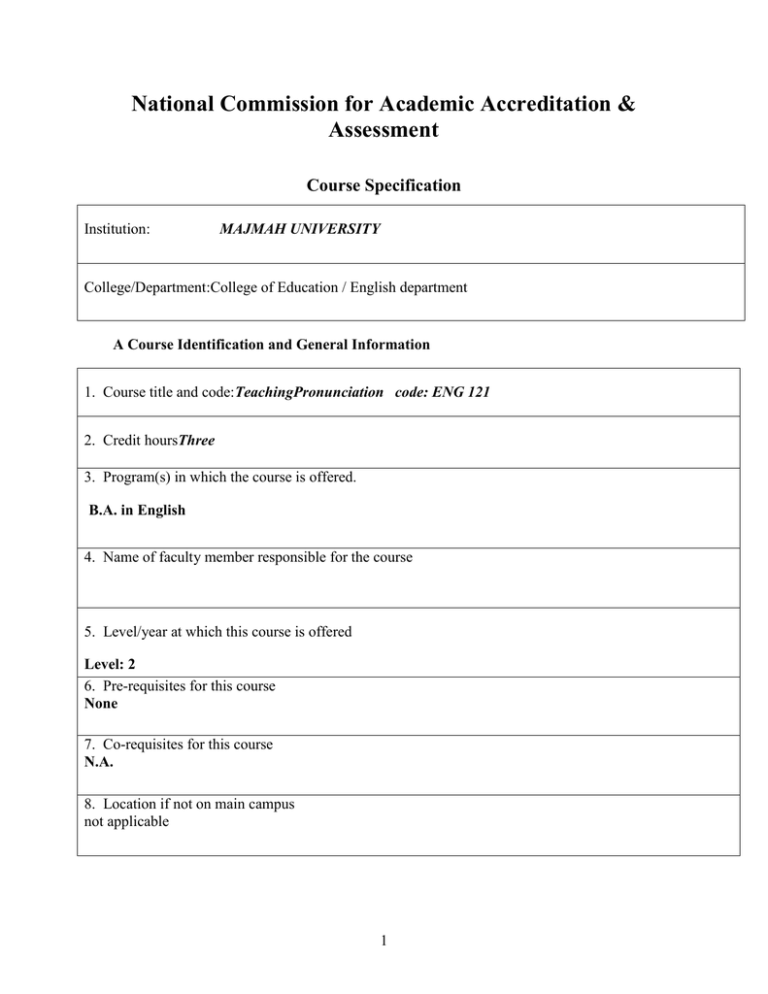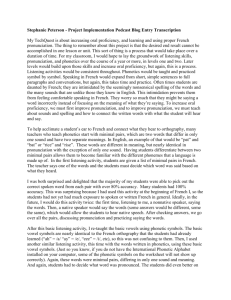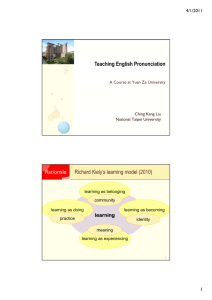ENG 121
advertisement

National Commission for Academic Accreditation & Assessment Course Specification Institution: MAJMAH UNIVERSITY College/Department:College of Education / English department A Course Identification and General Information 1. Course title and code:TeachingPronunciation code: ENG 121 2. Credit hoursThree 3. Program(s) in which the course is offered. B.A. in English 4. Name of faculty member responsible for the course 5. Level/year at which this course is offered Level: 2 6. Pre-requisites for this course None 7. Co-requisites for this course N.A. 8. Location if not on main campus not applicable 1 B Objectives This course is the first of a series of three courses in the department that are prescribed for the study and practice of English sounds ( the other two being: ENG 322 & ENG 314 ). As such, it assumes no previous background in Phonetics and Linguistics, and aims primarily at training students to both pronounce and understand English pronunciation effectively and intelligibly. Core topics will include: the pronunciation of English vowels, diphthongs, consonants, syllable, stress and intonation. The use of both paper and electronic dictionaries to know the pronunciation of English words, will be practiced (including of course phonetic transcription). Although the bulk of the course will be about practical pronunciation, a small module(section) that introduces some basic theoretical phonetic terms and concepts will also be included, but again with a practical orientation towards these concepts/terms ( definition of phonetics, its three major categories, organs of speech, description of English vowels/diphthongs and consonants, but not descriptions of suprasegmental). Students will not be trained on RP (Received Pronunciation) alone, but will also be trained to understand a wide range of English accents (native/non-native) (including the New English accents).drawing on the growing tendency in modern EFL education to incorporate New English as well as RP (see Jenkins, 2000(1st edition). Jenkins argues strongly for a model of English phonology ( what she calls "Lingua Franca Core") that caters for/accommodates nonnative-nonnative communication, based on" International Intelligibility", as English is now a 'Global Language' (rather than just the limited RP). Main Objectives: Introduces students to the basics of English pronunciation and its sound system structure. Provides students with a wide range of practices/exercises on English pronunciation drawing on a variety of accents ( not merely RP important as it is—see Jenkins, 2000). Gives students opportunity to practice English Supra-segmentals (Syllable-Stress- Connected Speech and intonation). Defines, describes and explains Phonetics (three major sub-fields of phonetics, with particular emphasis on articulation/organs of speech). Describes English vowels, diphthongs, consonants,(also gives insights into English phonetics vs. Arabic phonetics- "how sequences of sound segments are arranged cf. ENG 324). Seeks to make students feel the flow of English pronunciation (English Rhythmic structure being "stress-timed" ). 2 Learning outcomes: Pronounce and understand English correctly, effectively and intelligibly when talking or listening to both native and nonnative speakers of English. Pronounce English vowels and diphthongs correctly, effectively and intelligibly. Pronounce English consonants correctly, effectively and intelligibly. Note the discrepancy/inconsistencies between English script( Letters) an Sounds (instructors may draw on Section A in Donna's and Hancock's textbook- intermediate) Pronounce English supra-segmentals (Syllable, Stress: word and sentence stress, intonation, etc.) correctly, effectively and intelligibly-- (instructors may opt to draw on Donna's & Hancock's textbook section B) Pronounce English numbers, proper names and Geographical names correctly and intelligibly. Develop an awareness of the sound system of English. Possess a working knowledge of Phonetics (articulatory, acoustic and auditory phonetics). Know and use Phonetic Transcription (IPA); and effectively use English dictionaries to get the correct pronunciation ( both e-dictionaries and traditional paper dictionaries). Describe English vowels and consonants (place of articulation, manner of articulation and the position of the vocal cord) C.Course Description(Note: General description in the form to be used for the Bulletin or Handbook should be attached) 1. Topics to be Covered List of Topics No of Weeks Course Orientation: Note that the practical module (unit) of this 1 course draws on Donna's & Hancock's " English Pronunciation in Use" (or any similar practical pronunciation book with the audio (CD) materials) ! Pronunciation of English Vowels and Diphthongs ( 1 discrepancies between English spelling and sounds should be noted) 3 Contact hours 3 3 Pronunciation of English Consonants ( using minimal pairs and all sorts of exercises provided in Donna's and Hancock's "English Pronunciation in Use" (intermediate).. ( discrepancies between English spelling and sounds should be noted with the audio (CD) materials) Pronunciation of English Syllables( draw a comparison and contrast with Arabic syllables). 2 6 1 3 2 6 - Pronunciation of English numbers, proper names/geographical names) Module (unit 2): what is Phonetics? Branches of Phonetics: 2 Articulatory, Auditory and Acoustic)..Phonetic Transcription (IPA) Articulation: Slight description of Organs of Speech 2 6 - Pronunciation of English Stress (word stress) and Intonation 6 Description of English Vowels (Vowel Chart: tongue part, tongue height and lip position. Linking the phonetic description of English sounds (vowels and consonants) with English pronunciation practice. 2 6 1 3 English Phonetics vs. Arabic Phonetics (e.g. differences in consonant clusters). 1 3 2. Course components (total contact hours per semester): Lecture: 26 HR Tutorial: Laboratory 45 12 NA Practical/Field work/Internship N/A 3. Additional private study/learning hours expected for students per week. 2-3 hours/week 4. Development of Learning Outcomes in Domains of Learning For each of the domains of learning shown below indicate 4 Other: a. Knowledge (i) Description of the knowledge to be acquired 1: Correct place and manner of articulation of English sounds 2: Phonetic symbols which they can use to identify correct pronunciation of English words (ii) Teaching strategies to be used to develop that knowledge. Lectures - group discussion. Practice in small groups (iii) Methods of assessment of knowledge acquired i: Presentation ii: Written Quiz iii: Discussion iv: Exams b. Cognitive Skills (i) Description of cognitive skills to be developed 1- Recognizing different phonetic symbols 2- Recognizing different sounds 3-Ability to pronounce properly (ii) Teaching strategies to be used to develop these cognitive skills listening practice– lectures –individual and group learning (iii) Methods of assessment of students cognitive skills oral quiz, written quiz, exams c. Interpersonal Skills and Responsibility Working in groups Leader ship (ii) Teaching strategies to be used to develop these skills and abilities Group assignments Group discussions 5 (iii) Methods of assessment of students interpersonal skills and capacity to carry responsibility 1-Observation 2-Evaluating the student’s role as a team leader 3-Assessing the role of reader in group d. Communication, Information Technology and Numerical Skills i- learning the proper way to pronounce in English language ii-Using internet to get knowledge and utilize it properly (ii) Teaching strategies to be used to develop these skills i: using pronunciation training software ii: students accessing web-based practice material using computer N/A (iii) Methods of assessment of students communication skills 1- class presentations 2- Class discussions N/A 5. Schedule of Assessment Tasks for Students During the Semester Assessment Assessment task (eg. essay, test, group project, examination etc.) Each week Proportion of final assessment 1 1stMid- term 7th 15 2 2nd Mid- Term 14th 15 3 Participation/assignments/quizzes 4 10 15-16th Final Exam 6 60 D. Student Support Arrangements for availability of teaching staff for individual student consultations and academic advice. 1. 6 hours for academic consultation E: Learning Resources 1: Require Textbook English Pronunciation in Use- Intermediate (with CD-audio and CD-ROM) by Mark Hancock, and Sylvie Donna Other Reference: English Phonetics and Phonology by Peter Roach Cambridge University Press 2: Electronic materials - phonetics.ucla.edu soundsofenglish.org clas.mq.edu.au/speech/phonetics/topics.html 3: Other learning materials CDS with the books: English Pronunciation in Use A course in phonetics F. Facilities Required Indicate requirements for the course including size of classrooms and laboratories (ie number of seats in classrooms and laboratories, extent of computer access etc.) 1. Accommodation (Lecture rooms, laboratories, etc.) -Large rooms -Laboratory. 2. Computing resources laptop 7 smart board speakers 3. Other resources Computer lab G Course Evaluation and Improvement Processes 1: Strategies for Obtaining Student Feedback on Effectiveness of Teaching Questionnaires for students 2: Other Strategies for Evaluation of Teaching by the Instructor or by the Department Observation Testing the students 3: Processes for Improvement of Teaching Workshops Having confidence in teachers An effective system of encouragement for the teachers 4. Processes for Verifying Standards of Student Achievement. Rechecking by the head of the department Opinion about the assignments etc. from other staff members 8







